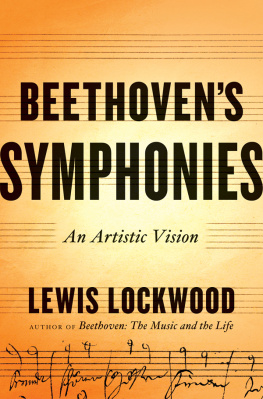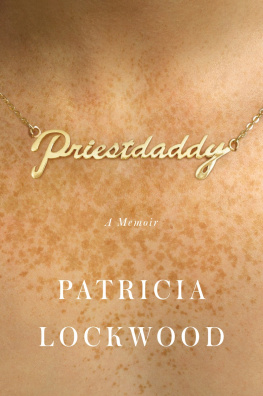
ALSO BY LEWIS LOCKWOOD
Beethoven: The Music and the Life
Beethovens Eroica Sketchbook: A Critical Edition
(co-edited with Alan Gosman)
Inside Beethovens Quartets
(co-authored with the Juilliard String Quartet)
The Beethoven Violin Sonatas
(co-edited with Mark Kroll)
Beethoven: Studies in the Creative Process
Music in Renaissance Ferrara, 14001505

Beethovens Symphonies
Copyright 2015 by Lewis Lockwood
All rights reserved
First Edition
For information about permission to reproduce selections from this book, write to Permissions, W. W. Norton & Company, Inc.,
500 Fifth Avenue, New York, NY 10110
For information about special discounts for bulk purchases, please contact W. W. Norton Special Sales at specialsales@wwnorton.com or 800-233-4830
Book design by JAMdesign
Production manager: Julia Druskin
The Library of Congress has cataloged the printed edition as follows:
Lockwood, Lewis.
Beethovens symphonies : an artistic vision / Lewis Lockwood. First edition.
pages cm
Includes bibliographical references and index.
ISBN 978-0-393-07644-8 (hardcover)
1. Beethoven, Ludwig van, 17701827. Symphonies. 2. Symphony19th
century. I. Title.
ML410.B42L62 2015
784.2184092dc23
2015022306
ISBN 978-0-393-24928-6 (e-book)
W. W. Norton & Company, Inc.
500 Fifth Avenue, New York, N.Y. 10110
www.wwnorton.com
W. W. Norton & Company Ltd.
Castle House, 75/76 Wells Street, London W1T 3QT
To the memory of my mother
MADELINE WARTELL LOCKWOOD
Poets are sieves
Brimming rose leaves;
Yielding when prod,
Attar of God.
M.W.L.
CONTENTS
The corrected copy of the Eroica Symphony, with a portion of the title page showing Beethovens cancellation of the dedication to Napoleon
EXAMPLES
All the music examples included or mentioned in this book may be found at musicexamples.com
A new book on the Beethoven Symphonies calls for justification. Readers may wonder what can possibly be added to current levels of familiarity with these famous works, which remain the core of the classical concert repertoire. Living as we do in an age of lightning-quick access to oceans of information, it is natural to assume that pretty much anything important about Beethoven is probably available at the touch of a finger.
And yet it is not true. Not true for many aspects of his life and career, and certainly not for the deeper understanding of his works and his artistic evolution. This book aims to provide an introduction to the Beethoven symphonies as individual works of art, with a focus on their historical, biographical, and creative origins. More than any other great composer of the past, Beethoven left to posterity a vast body of material that documents the early stages of almost every work he ever wrote. This patrimony is contained in the desk sketchbooks that he used at home and in the smaller pocket sketchbooks that he carried with him out of doors, especially in his later years. They have the potential to show us Beethoven as a working composer, deeply engaged in what he accepted as a lifetime commitment to bring forth all that I felt was within me, as he wrote in his Heiligenstadt Testament of 1802. That he managed to keep this ever-growing mass of sketch material largely intact suggests that he was protecting his inner creative world from the difficulties of his daily life across the years.
The Beethoven sketchbooks were first studied in the nineteenth century by the pioneering scholar Gustav Nottebohm, a friend of Brahms, whose essays and monographs are still fundamental. Yet for many reasons, only a handful have been published in fully reliable editions. This is partly because Beethovens musical notation is often hard to read and partly because Beethoven scholarship and the larger field of historical musicology in the twentieth century moved in other directions. Even now only about twenty percent of this vast material is available in transcription, and it was as late as 1985 that the first comprehensive catalogue of the sketchbooks was published, by Douglas Johnson, Alan Tyson, and Robert Winter.
This book reflects my years of Beethoven study and teaching, and is directly influenced by my recent work on the Eroica Sketchbook, the product of seven years of close collaboration with my colleague Alan Gosman. Our work resulted in the publication of its first complete critical edition in 2013. This sketchbook contains, among other things, the great mass of Beethovens known sketches for the Eroica Symphony and other works of its time, including the Waldstein Sonata. This project strengthened my belief that engagement with the primary sources of artistic masterworks remains a vital source of insight. Such engagement has the capacity to create links between history, biography, and analysis, and it opens up an unparalleled view of the inner musical world in which a great composers works originated.
A further consequence of these efforts will be found in the appendix to this book, which offers a synoptic overview of what we know of the incipient ideas for symphonies that Beethoven entered into his sketchbooks over the years. Many of these concept sketches for symphonies, though not all, have recently been discussed in a pathbreaking study by Erica Buurman. Her study, which is devoted entirely to sketches for multi-movement works, not those for single movements, also includes many concept sketches for works in other genres, such as the string quartets and piano sonatas.
My appendix is limited to Beethovens entries for symphonies, but does include those entries in which Beethoven wrote down ideas for single movements. A very few of the concept sketches listed in the appendix are for works that Beethoven went on to complete, including most conspicuously, the Eroica Symphony. It also includes his preliminary ideas for two movements of the Fifth Symphony, which he wrote down in this same Eroica Sketchbook, years before he came back to complete the Fifth in its final form. These entries are discussed in my chapters on the Eroica and the Fifth Symphonies.
Especially illuminating are a whole series of brief concept sketches, each marked Sinfonia or Sinfonie, which Beethoven wrote down as he was thinking about possible symphonies that never got beyond this incipient stage. In 1809, for example, we find brief ideas for symphonies in G minor, G major, and even a passing verbal reference to a symphony in A minor. Three years later, while writing the Seventh and Eighth Symphonies, he sketched ideas for possible symphonies in D minor, in B-flat major, in E minor, and in E-flat major, all of which remained gleams in his imagination. All of these and other entries combine to justify the view that for Beethoven the symphony was a lifetime preoccupation to which he returned at various times for both inner and outer reasons. These laconic entries reveal some of the rich creative soil from which the nine completed major works grew. Awareness of such a background enlarges our understanding of the finished works, and it should contribute to a larger and more wide-ranging portrait of Beethoven as a symphonic thinker than we have had before.
In short, this book can be read as a series of historically informed critical essays on each of the symphonies. In some chapters the historical and biographical background is prominent. In others, where the documentation permits, I offer a broad picture of aspects of the compositional background. The music examples in the book have been kept to a minimum but all the examples will be found at the Web site (musicexamples.com).
Next page

















